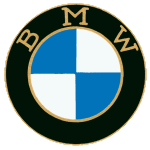


 |
Motorcycle Data Sheet Model: 1963 BMW R50/2 (conversion) Nickname: "Wolf" (Der Weißer Wolf AKA the White Wolf) Engine: 495cc 2-valve boxer twin converted to later 797cc (50 HP, low-compression) Years of Production: 1960-1969 Number Produced: 19,036 Purchase Date: August 2003 Previous Location: Penngrove, CA Previous Owners: Unknown Mileage at Purchase: 0 (Rebuilt) Mileage Since Engine Rebuild: 0 Restoration Projection: A lot... Restoration Costs to Date: $5,575 |
After obtaining some practice rebuilding some classic '70s Beemers up from a bare frame, this motorcycle, which was sold to me on eBay as a frame only, stripped and ready for repainting and restoration, was my first foray into "vintage" Beemers, built during or before 1969 at the original Münich factory. This bike had started its life as a 1963 R50/2, a classic middle-displacement tourer of its day. I am rebuilding it as a "/2 conversion" using the '60s chassis with a '70s engine, electrical system, wheels, and other parts. When I first saw this /2 twin-loop frame, I already had many spare Airhead parts from my '70s bikes left over from my other ongoing motorcycle restorations, including a complete 600cc engine and a good /5 front end; a conversion seemed like a great way to use some of these spares and get in on the vintage bike mojo with more practicality and without the hefty front-end investment or the long-term maintenance hassle. There is a significant subset of the classic/vintage BMW motorcycle community interesed in discussing and performing these conversion projects. (In November 2003 I embarked on a second /2 conversion project using a later, stronger frame, thereby keeping my sidecar dreams alive...)
As the project evolved, I decided upon and began piecing together an Earles leading link fork for the front end, in place of the /5 telescopic fork I already had, a model essentially identical to the model fit to US-market /2s after 1967. I was willing to trade off some quickness in steering for the Earles' sublimely plush and compliant ride.
| The riding comfort provided by a combination of sprung saddle and suspension impossible to fault was a revelation. With one possible exception, the R69 is the best-sprung machine in the rider's longish experience. Since the front end is made under Earles' license, part of the credit obviously belongs to Birmingham! Readily adjustable by means of a built-in tommy bar on each leg, the rear springing harmonized well with the front, giving superb road-holding under all conditions. -- Motor Cycling, April 1956 |


Above left: Jeffrey Roddick's R60/2 in Dover White with Earles front end
Above right: (Clockwise from top) Used /2 swingarm, fenders, fork, crash bars, and centerstand
Even with straight forks, the real kick in the pants on the Earles front end -- which I failed to research adequately before plunging headlong into assembling one -- is the cost of assembling the suspension units. I scoured the Internet for a restorable swingarm front end with all of its own unique bits and pieces that were incompatible with the parts from the later telescopic fork. I could also no longer use my /5 front wheel, brakes, or fender; I sourced /2 versions of the brake backing plate and front fender (at additional expense), and looked into modifying an extra /5 rear wheel (the same 18" diameter as the /2 wheel) to fit the Earles fork setup. In addition, pretty much everything on the Earles comes "a la carte"; With upper and lower covers, eyelets, springs, shock cartridges, and silent bushings all sourced and purchased separately, the costs really add up, and one could very well find two good used or rebuilt Airhead telescopic forks -- plus adapters to mount them on a /2 frame -- for less than the cost of a single operational leading link fork.
Well, now I know the ins and outs of the Earles fork. "Low front-end investment" (no pun intended) has pretty much been my mantra since I have begun to learn the ropes of motorcycling and motorcycle restoration. I have purchased entire running motorcycles for less than what one bloody Earles is going to cost me. The mounting costs of putting an Earles fork, however cushy, on a bike that was intended as a solo ride rather than a sidecar hauler, convinced me to revisit the logic of a leading link front end for this project, and I went settled a telescopic fork, taking solace in the hope that the orphaned Earles components I have will be useful when I start building up my '65 conversion sidecar outfit. Maybe at some point in the future, I'll fit an Earles fork to the solo conversion bike, but for now, I'll appreciate the quick steering, cost effectiveness, and disc-brake compatability of an Airhead telescopic front end. (Even that choice requires some engineering adjustments to accommodate the brake master cylinder and later-style throttle.)
When complete, I am confident that this bike will make a sporty, stylish city and highway mount with a lot of poise on the road...
Restoration
This motorcycle is essentially just lying in boxes in my storage unit and on the shelves in my home office. Here are the major components I have been able to source to date, including copious spares already on hand from my other projects:


Above right: Steering head bearings and telescopic fork adapters for /2
Above left: Jeff Deans's R60/2 in Dover White
Reconstruction Chronology
September 2003
December 2003
January 2004
April 2004
Acknowledgments
Thanks to the following individuals for assisting in this restoration project: Allan Atherton, Duane Ausherman, Barry Bialik, Howard Bialik, Karin Bishop, Ryan Blank, Barbara Bynum, Brock Downey, Barry Dwyer, Virgil Elliott, Brendan Ferrer, Fred Inman, David Makin, Nathan Mende, Charlie Moore, DL Powers, Jeff Roddick, Chuck Sherman, Tom Sill, Bo Stewart, Robert Valdez, Mick Vallantine, Craig "Vech" Vechorik, Elaine Vechorik, and Ted Witting.